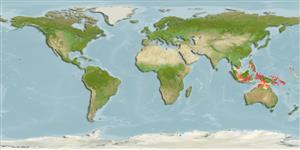Common names from other countries
>
Gobiiformes (Gobies) >
Gobiidae (Gobies) > Gobiinae
Etymology: Trimma: Greek, trimma, -atos = something crushed (Ref. 45335); haimassum: Name from the Greek word 'haimasso' meaning stained with blood, referring to the blood-red spot above the posterior end of the opercle in live and fresh specimens..
More on author: Winterbottom.
Environment: milieu / climate zone / depth range / distribution range
Οικολογία
Θαλασσινό(ά) βενθικό(ς); εύρος βάθους 7 - 70 m (Ref. 87358). Tropical
Western Pacific: from Indonesia (SW Sulawesi) north to the Philippines (Palawan) and eastwards to the Solomon Is., probably also in Palau.
Μέγεθος / Βάρος / Age
Maturity: Lm ? range ? - ? cm
Max length : 3.1 cm SL αρσενικό/απροσδιόριστο; (Ref. 87358)
Short description
Κλείδες προσδιορισμού | Μορφολογία | Μορφομετρία
Ραχιαίες άκανθες (συνολικά) : 7; Μαλακές ραχιαίες ακτίνες (συνολικά) : 10; Εδρικές άκανθες: 1; Μαλακές εδρικές ακτίνες: 8 - 10. This species is characterized by having the following characters: a relatively deep body, numerous irregular scales with about 30 lateral rows and over 15 scales in the anterior transverse series, a fifth pelvic fin ray that branches twice dichotomously, usually a somewhat elongate second dorsal spine, no predorsal, cheek or opercular scales, a moderately wide bony interorbital with a fleshy median ridge between the eyes, and a dermal ridge anterior to the first dorsal spine. There is a red spot or elongate blotch above the opercle in live and fresh material, and the dorsal surface of the snout has a reticulated dark pattern, with dark transverse stripes over the dorsal margin of the orbit (Ref. 87358).
Inhabits caves and ledges on steep outer reef slopes (Ref. 90102).
Life cycle and mating behavior
Maturities | Αναπαραγωγή | Spawnings | Egg(s) | Fecundities | Προνύμφες
Winterbottom, R., 2011. Six new species of the genus Trimma (Percomorpha; Gobiidae) from the Raja Ampat Islands, Indonesia, with notes on cephalic sensory papillae nomenclature. aqua, Int. J. Ichthyol. 17(3):127-162. (Ref. 87358)
IUCN Red List Status (Ref. 130435)
CITES (Ref. 128078)
Not Evaluated
Threat to humans
Harmless
Human uses
Εργαλεία
Special reports
Download XML
Διαδικτυακές πηγές
Estimates based on models
Preferred temperature (Ref.
115969): 28 - 29, mean 28.5 (based on 82 cells).
Phylogenetic diversity index (Ref.
82804): PD
50 = 0.5000 [Uniqueness, from 0.5 = low to 2.0 = high].
Bayesian length-weight: a=0.01023 (0.00477 - 0.02194), b=3.02 (2.84 - 3.20), in cm Total Length, based on LWR estimates for this (Sub)family-body shape (Ref.
93245).
Fishing Vulnerability (Ref.
59153): Low vulnerability (10 of 100).
